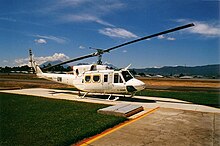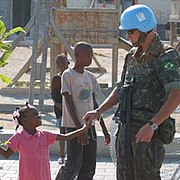History of United Nations peacekeeping
The United Nations Peacekeeping efforts began in 1948.[1] Its first activity was in the Middle East to observe and maintain the ceasefire during the 1948 Arab–Israeli War. Since then, United Nations peacekeepers have taken part in a total of 72 missions around the globe, 12 of which continue today. The peacekeeping force as a whole received the Nobel Peace Prize in 1988.
Though the term "
Early years
The
Before any official peacekeeping mission, the UN played an important role in the conflict concerning Trieste after World War II. From 1947 to 1954, Trieste was declared an independent city state under the protection of the United Nations as the Free Territory of Trieste. The territory was divided into two zones, which later formed the basis for the division of the territory between Italy and Yugoslavia. The UN also authorized two nations to station troops in the Free Territory, the US (Trieste United States Troops) and the UK (British Element Trieste Force) in the northern zone and Yugoslavia in the southern zone.
The first UN peacekeeping mission was a team of observers deployed to the Middle East in 1948, during the
In 1956, the UN responded to the
Cold War
Throughout the
International conflicts
The UN Peacekeeping Force in Cyprus, begun in 1964, attempted to end the
There was one exception to the rule. In the Mission of the Representative of the Secretary-General in the
Decolonization
The UN also assisted with two
Middle East conflicts
The Middle East, where combatants were generally not firmly aligned with the superpowers, who mainly sought stability in the crucial oil-producing region, was the most visible location of UN peacekeeping during the Cold War. In 1958,
End of the Cold War

With the decline of the Soviet Union and the advent of
With the end of the Cold War, a number of nations called for the UN to become an organization of world peace and do more to encourage the end to conflicts around the globe. The end of political gridlock in the Security Council helped the number of peacekeeping missions increased substantially. In a new spirit of cooperation, the Security Council established larger and more complex UN peacekeeping missions. Furthermore, peacekeeping came to involve more and more non-military elements that ensured the proper operation of civic functions, such as elections. The UN
A number of missions were designed to end civil wars in which competing sides had been sponsored by Cold War players. In
Post Cold War
International conflicts

In 1991, the political situation created by the collapse of the USSR allowed the first explicitly-authorized operation of collective self-defense since the Korean War: expelling
Civil Wars
The 1990s also saw the UN refocus its attention on genocide and ethnic cleansing. The Civil War in

Despite the cessation of international, Cold-War inspired aid, civil wars continued in many regions and the UN attempted to bring peace. Several conflicts were the cause of multiple peace-keeping missions.
The collapse of
The
A coup in
In
The UN has also organized single peacekeeping missions aimed at ending civil wars in a number of countries. In Central African Republic, MINURCA (1998) was created to oversee the disarmament of several mutinous groups of former CAR military personnel and militias as well as to assist with the training of a new national police and the running of elections. The mission was extended after successful elections to help ensure further stability. In

Independence facilitation efforts
UN Peacekeepers have also been used to oversee independence movements and the establishment of new states. Beginning in 1989,
Assessment

A 2005 RAND Corporation study found the UN to be successful in two out of three peacekeeping efforts. It compared UN nation-building efforts to those of the United States, and found that seven out of eight UN cases are at peace, as opposed to four out of eight US cases at peace.[12] Also in 2005, the Human Security Report documented a decline in the number of wars, genocides and human rights abuses since the end of the Cold War, and presented evidence, albeit circumstantial, that international activism—mostly spearheaded by the UN—has been the main cause of the decline in armed conflict since the end of the Cold War.[13]
The UN has also drawn criticism for perceived failures. In some cases, the Security Council has failed to pass resolutions or the
One suggestion to address the problem of delays such as the one in Rwanda, is a rapid reaction force: a standing group, administered by the UN and deployed by the Security Council that receives its troops and support from current Security Council members and is ready for quick deployment in the event of future genocides.[21]
UN peacekeepers have also been accused of sexual abuse including child rape, gang rape, and soliciting prostitutes during peacekeeping missions in the Congo,[22] Haiti,[23][24] Liberia,[25] Sudan,[26] Burundi, and Côte d'Ivoire.[27]
In response to criticism, including reports of sexual abuse by peacekeepers, the UN has taken steps toward reforming its operations. The Brahimi Report was the first of many steps to recap former peacekeeping missions, isolate flaws, and take steps to patch these mistakes to ensure the efficiency of future peacekeeping missions.[28] The UN has vowed to continue to put these practices into effect when performing peacekeeping operations in the future. The technocratic aspects of the reform process have been continued and revitalised by the DPKO in its 'Peace Operations 2010' reform agenda. The 2008 capstone doctrine entitled "United Nations Peacekeeping Operations: Principles and Guidelines"[29] incorporates and builds on the Brahimi analysis.
In 2013, the
See also
- List of United Nations peacekeeping missions
- History of the United Nations
- Timeline of United Nations peacekeeping missions
- International Day of United Nations Peacekeepers
- Attacks on humanitarian workers
References
- ^ "Our history". United Nations Peacekeeping.
- ^ "The Nobel Peace Prize 1957". Nobel Foundation. Retrieved 2010-04-12.
- ^ Paul F. Diehl, Peace Operations (Polity Press, 2008), pp. 34–36.
- ^ Year: 1948), UN Security Council (3rd (1964). "Resolution 50 (1948) /: [adopted by the Security Council at its 310th meeting], of 29 May 1948".
{{cite journal}}: Cite journal requires|journal=(help)CS1 maint: numeric names: authors list (link) - ^ "International Day of UN Peacekeepers, 29 May".
- ^ General Assembly Resolution 1000 (ES-I)UN Doc A/RES/1000 (ES-I) of 5 November 1956 Establishment of the UNEF Archived 19 May 2008 at the Wayback Machine
- ISBN 978-0-14-317269-7.
- ^ 1950s United Nations Peacekeeping http://www.un.org/events/peacekeeping60/1950s.shtml
- ^ "ONUC".
- ^ "United Nations Security Force in West New Guinea (Unsf)".
- ^ Baczko, Adam; Dorronsoro, Gilles. "United Nations Good Offices Mission in Afghanistan and Pakistan (UNGOMAP)".
- ^ RAND Corporation. "The UN's Role in Nation Building: From the Congo to Iraq" (PDF). Retrieved 2008-12-30.
- ^ Human Security Centre. "The Human Security Report 2005". Archived from the original on 2009-07-28. Retrieved 2007-02-08.
- ^ Harsch, Ernest (April 2004). "The world reflects on Rwanda genocide". UN. Retrieved November 3, 2022.
- ^ Feil, Scott (April 1998). "Preventing Genocide How the Early Use of Force Might Have Succeeded in Rwanda". Wilson Center. Archived from the original on July 6, 2010. Retrieved May 29, 2011.
- S2CID 154818651. Archived from the original(PDF) on 2011-08-26.
- ^ "Srebrenica Report Blames UN". BBC. Nov 16, 1999. Retrieved May 29, 2011.
- JSTOR 20045500.
- ^ "Darfur Resolution Historic Failure". Human Rights Watch. September 17, 2004. Retrieved May 29, 2011.
- ^ "Annan acknowledges UN failure to protect in Darfur". Sudan Times. December 9, 2006. Retrieved May 29, 2011.
- ISSN 0362-4331. Retrieved 2023-02-22.
- Washington Post.
- ^ "UN troops face child abuse claims". BBC News. 2006-11-30.
- ^ "108 Sri Lankan peacekeepers in Haiti to be repatriated after claims they paid prostitutes". International Herald Tribune. 2007-11-02.
- ^ "Aid workers in Liberia accused of sex abuse". International Herald Tribune. 2006-05-08.
- ^ Holt, Kate; Hughes, Sarah (2007-01-04). "UN staff accused of raping children in Sudan". Telegraph. London. Archived from the original on 2007-01-04. Retrieved 2010-05-04.
- ^ "UN staff accused of raping children in Sudan". BBC. 2007-05-28.
- ^ "Report of the Panel on United Nations Peace Operations". United Nations.
- ^ UN Peacekeeping Operations: Principles and Guidelines PDF pbpu.unlb.org/PBPS/Library/Capstone_Doctrine_ENG.pdf
- ^ "Corruption & Peacekeeping: Strengthening Peacekeeping and the United Nations" (PDF). Transparency International. October 2013. Archived from the original (PDF) on March 4, 2016. Retrieved October 29, 2013.
- ^ Gladstone, Rick (October 9, 2013). "Peacekeeping by U.N. Faces New Scrutiny on 2 Fronts". The New York Times. Retrieved October 29, 2013.
Further reading
- JSTOR 2622309.
External links
- UN peacekeeping home includes history, news, and links to other related UN sites. (English, Arabic, Chinese, French, Russian, Spanish)
- UN peacekeeping proposal: The presentation of the Eurocorps-Foreign Legion concept and its Single European Regiment at the European Parliament in June 2003
- A historical perspective of UN peace-keeping
